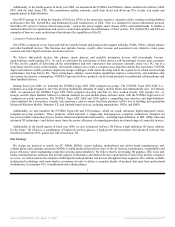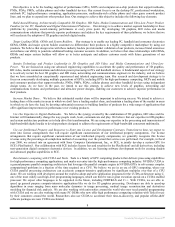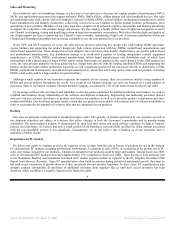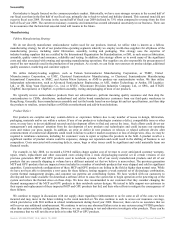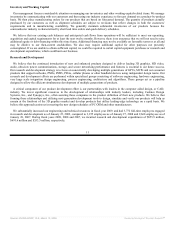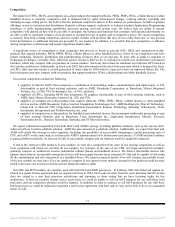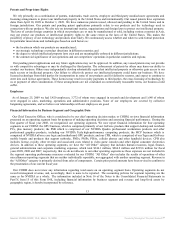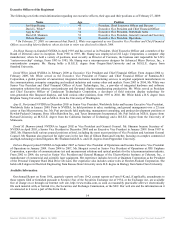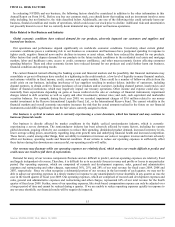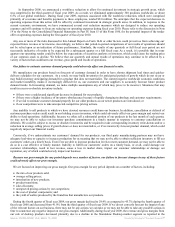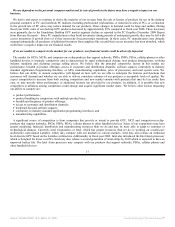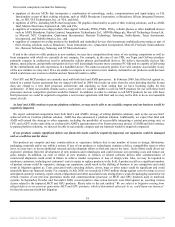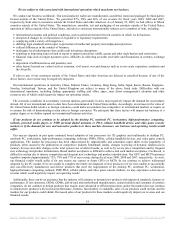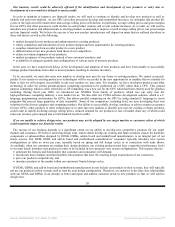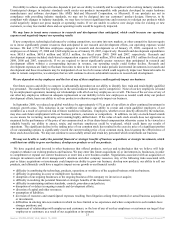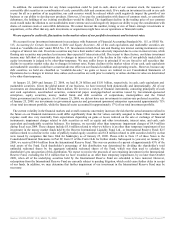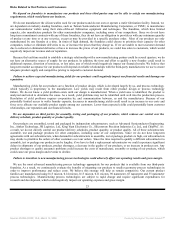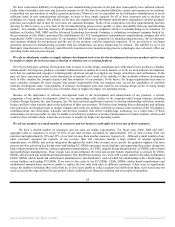NVIDIA 2009 Annual Report Download - page 19
Download and view the complete annual report
Please find page 19 of the 2009 NVIDIA annual report below. You can navigate through the pages in the report by either clicking on the pages listed below, or by using the keyword search tool below to find specific information within the annual report.
In September 2008, we announced a workforce reduction to allow for continued investment in strategic growth areas, which
was completed in the third quarter of fiscal year 2009. As a result, we eliminated approximately 360 positions worldwide, or about
6.5% of our global workforce. During fiscal year 2009, expenses associated with the workforce reduction, which were comprised
primarily of severance and benefits payments to these employees, totaled $8.0 million. We anticipate that the expected decrease in
operating expenses from this action will be offset by continued investment in strategic growth areas. In addition, in response to the
current economic environment, we have commenced several cost reduction measures which are designed to reduce our operating
expenses and will continue to focus on reducing our operating expenses during fiscal year 2010. Please refer to the discussion in Note
19 to the Notes to the Consolidated Financial Statements in Part IV, Item 15 of this Form 10-K for the potential impact of the tender
offer on operating expenses during the first quarter of fiscal year 2010.
Any one or more of the risks discussed in this Annual Report on Form 10-K or other factors could prevent us from achieving our
expected future revenue or net income. Accordingly, we believe that period-to-period comparisons of our results of operations should
not be relied upon as an indication of future performance. Similarly, the results of any quarterly or full fiscal year period are not
necessarily indicative of results to be expected for a subsequent quarter or a full fiscal year. As a result, it is possible that in some
quarters our operating results could be below the expectations of securities analysts or investors, which could cause the trading price
of our common stock to decline. We believe that our quarterly and annual results of operations may continue to be affected by a
variety of factors that could harm our revenue, gross profit and results of operations.
Our failure to estimate customer demand properly could adversely affect our financial results.
We manufacture our products based on forecasts of customer demand in order to have shorter shipment lead times and quicker
delivery schedules for our customers. As a result, we may build inventories for anticipated periods of growth which do not occur or
may build inventory anticipating demand for a product that does not materialize. The current negative worldwide economic conditions
and market instability makes it increasingly difficult for us, our customers and our suppliers to accurately forecast future product
demand trends. In forecasting demand, we make multiple assumptions any of which may prove to be incorrect. Situations that may
result in excess or obsolete inventory include:
• if there were a sudden and significant decrease in demand for our products;
• if there were a higher incidence of inventory obsolescence because of rapidly changing technology and customer requirements;
• if we fail to estimate customer demand properly for our older products as our newer products are introduced; or
• if our competition were to take unexpected competitive pricing actions.
Any inability to sell products to which we have devoted resources could harm our business. In addition, cancellation or deferral of
customer purchase orders could result in our holding excess inventory, which could adversely affect our gross margin and restrict our
ability to fund operations. Additionally, because we often sell a substantial portion of our products in the last month of each quarter,
we may not be able to reduce our inventory purchase commitments in a timely manner in response to customer cancellations or
deferrals. We could be subject to excess or obsolete inventories and be required to take corresponding inventory write-downs and/or a
reduction in average selling prices if growth slows or does not materialize, or if we incorrectly forecast product demand, which could
negatively impact our financial results.
Conversely, if we underestimate our customers’ demand for our products, our third party manufacturing partners may not have
adequate lead-time or capacity to increase production for us meaning that we may not be able to obtain sufficient inventory to fill our
customers’ orders on a timely basis. Even if we are able to increase production levels to meet customer demand, we may not be able to
do so in a cost effective or timely manner. Inability to fulfill our customers’ orders on a timely basis, or at all, could damage our
customer relationships, result in lost revenue, cause a loss in market share, impact our customer relationships or damage our
reputation, any of which could adversely impact our business.
Because our gross margin for any period depends on a number of factors, our failure to forecast changes in any of these factors
could adversely affect our gross margin.
We are focused on improving our gross margin. Our gross margin for any period depends on a number of factors, including:
• the mix of our products sold;
• average selling prices;
• introduction of new products;
• product transitions;
• sales discounts;
• unexpected pricing actions by our competitors;
• the cost of product components; and
• the yield of wafers produced by the foundries that manufacture our products.
During the fourth quarter of fiscal year 2009, our gross margin declined to 29.4% as compared to 45.7% during the fourth quarter of
fiscal year 2008 and decreased from 41.0% from the third quarter of fiscal year 2009. If we do not correctly forecast the impact of any
of the relevant factors on our business, there may not be any actions we can take or we may not be able to take any possible actions in
time to counteract any negative impact on our gross margin. Additionally, during fiscal year 2009, the revenue and gross margins from
our sale of desktop products decreased primarily due to a decline in the Standalone Desktop market segment as reported in the
Source: NVIDIA CORP, 10-K, March 13, 2009 Powered by Morningstar® Document Research℠


